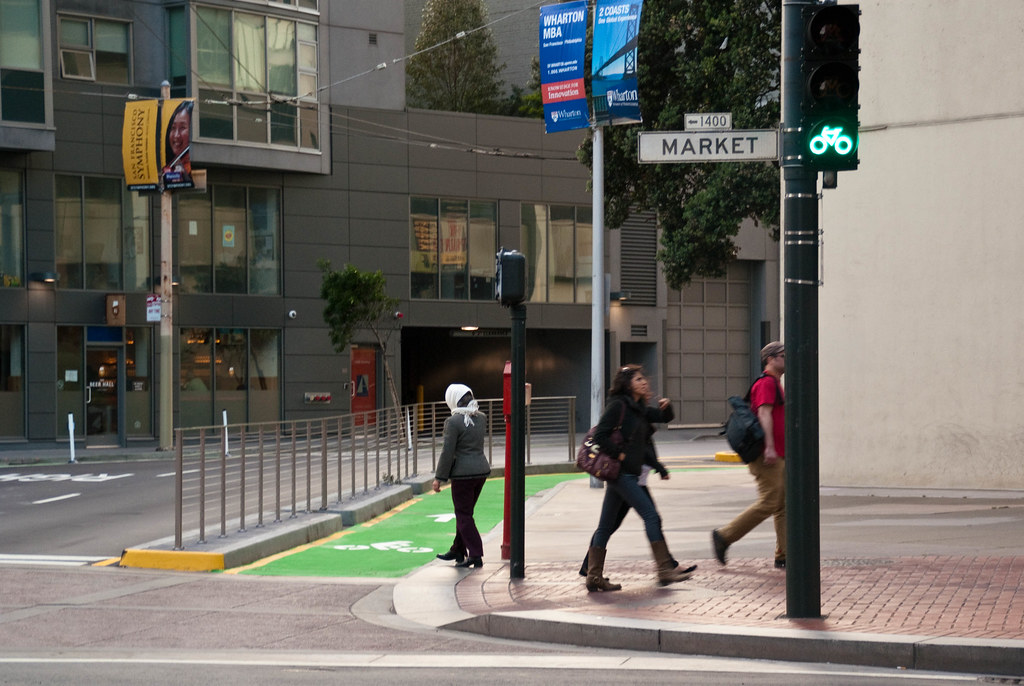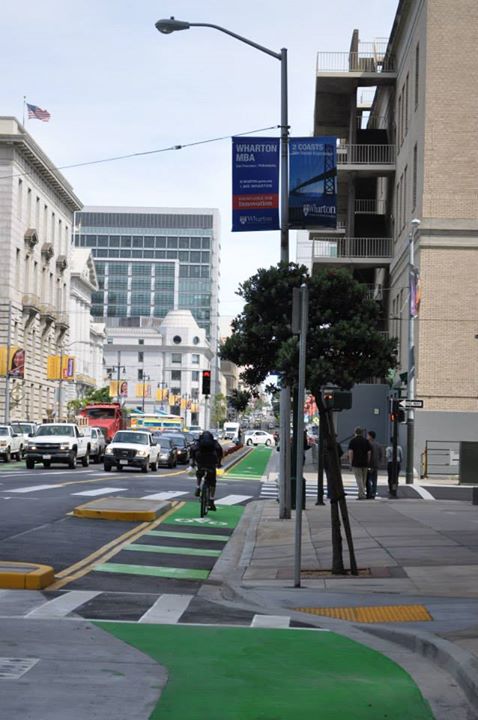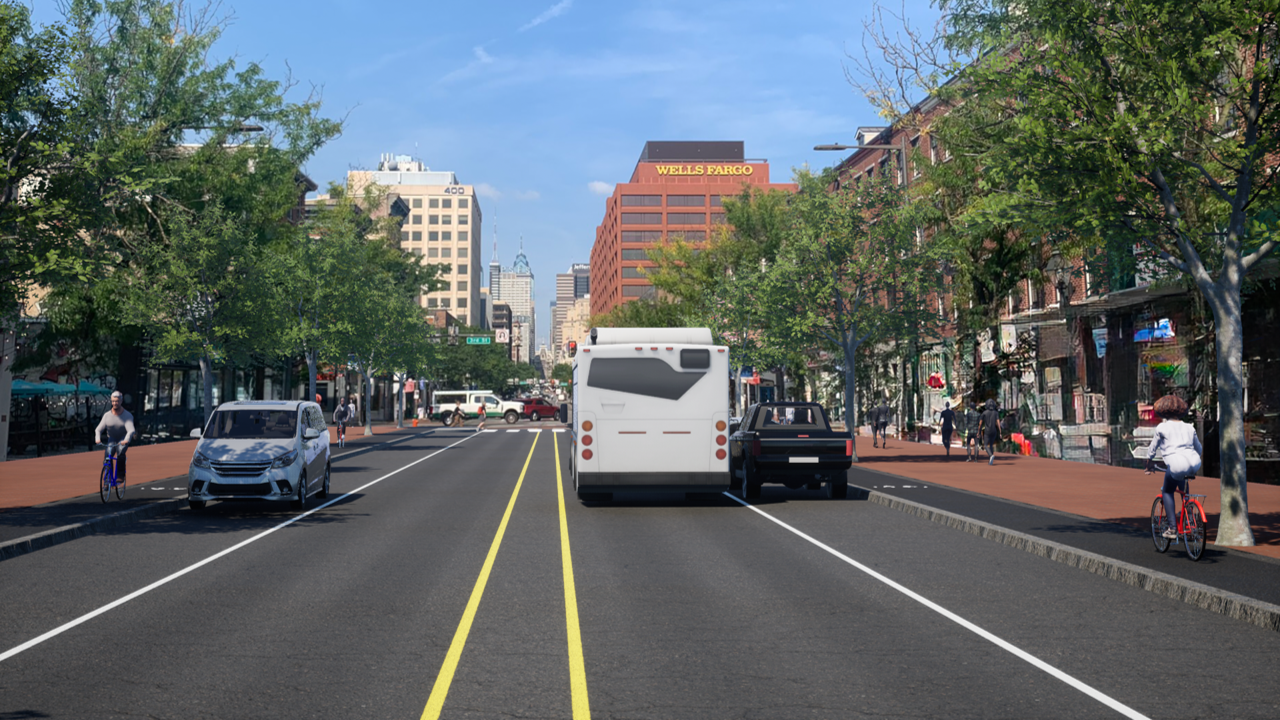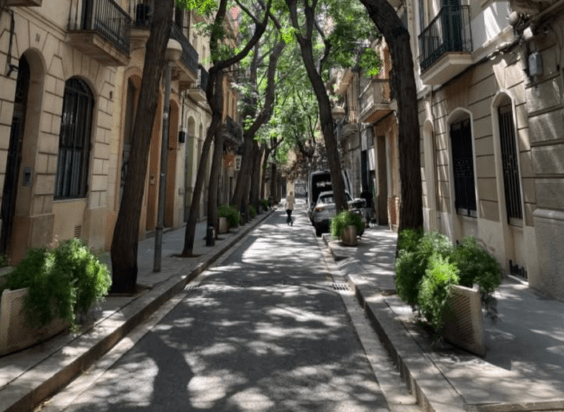
On the two southernmost blocks of Polk Street, between Market Street and City Hall, the new contra-flow protected bike lane creates a unique street layout for San Francisco. For the first time on a downtown street, people on bikes are accommodated in a way that people in cars are not. Bike traffic goes both ways, while cars only go one.
It's one of several ways in which this short stretch is more powerful than the sum of its two blocks. The Polk contra-flow lane is the best segment of bicycle infrastructure in San Francisco, acting as a real-world showcase of what's possible for a citywide network of high-quality bicycle routes.
The Polk contra-flow lane is "a game changer, without a doubt," said Leah Shahum, executive director of the SF Bicycle Coalition. "People can now see with their own two eyes and ride on what is a model for a great bike facility. We don't have to theorize about what could be, or show pictures of European cities. We can literally look at what is a well-designed, inviting and safe bikeway that lives up to the '8-to-80' promise that city leaders have committed to."
The new bike lane is the first to be separated from motor traffic with a concrete planted median, with parking spaces acting as an extra buffer at some spots. It features bicycle traffic signals, green paint for high visibility, and clear pavement markings at the Market Street intersection to guide bike commuters to the entrance.
Where the protected bike lane ends at Grove Street, and two-way motor traffic returns, riders aren't totally thrown back into the fray, either. A green bike lane segment was added across the front of City Hall, and it was made safer with car parking re-configured to back-in angled parking. This treatment goes to McAllister Street, where the rest of Polk is being re-designed as a separate project.
"They're now seeing those bread crumb trails, where they can get from point A to point B," said Tim Papandreou, the SFMTA's director of strategic planning and policy. Papandreou is overseeing the development of the SFMTA's Bicycle Strategy, a guide for the city's next generation of bicycle improvements.
The SFMTA created a metric called "Level of Traffic Stress" to measure the quality of bike route segments. It is based on how easy and comfortable a bike route feels for the average person. The Polk contra-flow lane is a prime example of "LTS 1," the lowest level of stress, meaning the street is considered to be accessible by San Franciscans of all riding abilities, says Papandreou.
"When we point now to Level of Traffic Stress 1, comfortable cycling for everybody, that's exactly what we're talking about," he said. "With the will of the leadership, and funding, we can do more of that."
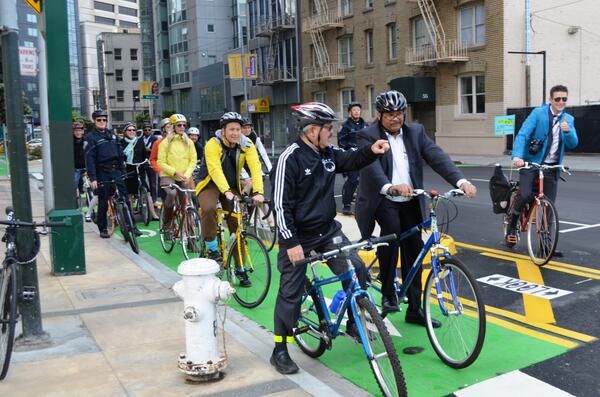
As it happens, the Polk lane acts as a sort of green carpet to City Hall, a highly visible invitation to SF's public officials to roll up to work themselves. "Every decision maker coming in and out of this building will now be reminded of the importance of bicycling in our city, and the potential it holds to make San Francisco a better place," said Shahum.
"The ability to cross from Market to come over to City Hall is absolutely amazing," said Supervisor London Breed at the Bike to Work Day press conference last week.
Passersby, on bikes or not, will also be getting a close look at the new standard for protected bike lanes in SF. "Even for people who may never get on a bike, this is a chance for people to see and understand the benefits of dedicated bike space, for non-bicyclists too," said Shahum. "This is a tremendously more predictable street, whether you're walking, biking, or driving."
The new lane links some fast-changing neighborhoods. Market and Polk is the doorstep of Twitter and new high-rise condos, and people can now bike easily to and from the Tenderloin, and the restaurants and nightlife on middle and upper Polk.
"Safer connections between south-of-Market and north-of-Market strengthens the Central Market, Civic Center and Tenderloin communities," said Tracy Everwine, executive director of the Central Market Community Benefit District. "It’s fantastic DPW prioritized this much-needed infrastructure project to help us become a more bicycle friendly district."
Everwine was referring to the fact that the project was only built in time for Bike to Work Day after a push from Department of Public Works chief Mohammed Nuru, at the urging of the SFBC. The contra-flow lane was proposed ten years ago, and is one of the last projects to be implemented from the 2009 SF Bike Plan.
"People waited a long time," said Papandreou. "This is a 15-year overnight success."
It also figures to be the forerunner of several more high-quality bike lanes planned for other streets in the coming years. Raised bike lanes are set to hit Second Street and Masonic Avenue in the next two years, and they've been proposed for the Better Market Street project, along most of that corridor.
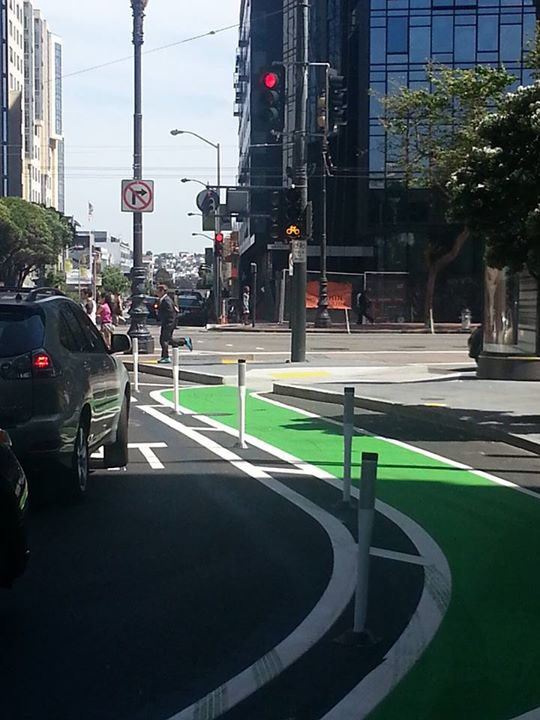
Next year, construction is planned for a redesign on Polk north of McAllister to Union Street, but merchants obsessed with preserving car parking have prevented protected bike lanes on most of that segment. A raised, protected bike lane will extend up to California Street, but the segment north of California to Union Street will only get sharrows in one direction and a conventional bike lane, between parked cars and moving cars, in the other.
The southbound side of most of Polk is set to get a green buffered bike lane that will run either curbside or next to parked cars, depending on the block. It would be similar to the setup put in place on the southbound side south of Grove Street, where the bike lane was upgraded with green paint and plastic posts, and widened, to complement the new contra-flow lane.
Shahum said the cheap and easy measures like paint and posts -- similar to what's been in place on mid-Market for a few years -- are "nice to have," and it adds to the "continuity" of the bike network that's needed.
But the real model is across the street, she said, where the real physical protection offered by the contra-flow lane represents "the level of safety and comfort that we know we're going to need in the city to help bring out the next generation of prospects of people that are bicyclists."
"This is basically mainstreaming bicycling for a few blocks on a San Francisco street," she said. "We're not just squeezing in the margins anymore."
